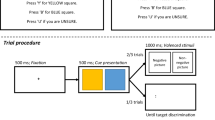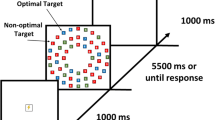Abstract
Anxiety is reliably associated with an attentional bias favoring threatening information which is thought to be a key mechanism in the etiology and maintenance of anxious pathology. However, whether and how anxiety is related to attentional capture at a more basic level (i.e., in the absence of threat) is less well understood. To address this gap in the literature, we examined the association between anxiety and attentional capture in the context of visually salient, yet affectively neutral, stimuli. Specifically, we used a visual search task in which participants were required to locate a target while ignoring a salient distractor stimulus. A total of 122 undergraduates—half of whom were assigned to a state-anxiety induction—completed this task while event-related potentials were recorded and also completed self-report measures of trait and state anxiety. The results revealed that trait anxiety, but not state anxiety, was associated with impaired attentional control in the presence of a salient distractor. That is, behavioral slowing and the N2pc event-related potential—a neural measure of attentional selection—were enhanced for trait-anxious participants when the distractor was proximate to the target and required controlled attention in order to inhibit it. These findings extend previous work by providing evidence from multiple levels of analysis that attentional aberrations in anxiety reflect broad deficits in inhibiting distracting stimuli and are not limited to threat-relevant contexts.


Similar content being viewed by others
Notes
Referring to both the RT and N2pc as “distractors costs” is a convenience to aid in the reading of this text; it is not to imply a relationship between these measures or to posit a theoretical explanation for the effect of distractors on these measures.
Note that, since the N2pc is a negative deflection, this negative correlation should be interpreted as a positive association. That is, greater anxiety predicted greater N2pc enhancement.
We quantified the N2pc elicited on lateral target/contralateral distractor trials across the entire time window (200–300 ms). However, some authors (Hickey et al., 2006) have divided this time window into two segments: an early segment characterized by a positivity (i.e., target-contralateral activity was less negative because attention was initially allocated to the distal distractor), and a later time window characterized by the standard N2pc effect (greater negativity at target-contralateral sites). On the basis of visual inspection, we divided the contralateral distractor N2pc wave into two segments: 200–240 and 240–300 ms. However, neither of the costs were related to anxiety (ps > .31).
References
American Psychiatric Association. (2013). Diagnostic and statistical manual of mental disorders (DSM-5) (5th ed.). Washington, DC: American Psychiatric Association.
Amir, N., Beard, C., Burns, M., & Bomyea, J. (2009). Attention modification program in individuals with generalized anxiety disorder. Journal of Abnormal Psychology, 118, 28–33. doi:10.1037/a0012589
Bar-Haim, Y., Lamy, D., Pergamin, L., Bakermans-Kranenburg, M. J., & van IJzendoorn, M. H. (2007). Threatrelated attentional bias in anxious and nonanxious individuals: A meta-analytic study. Psychological Bulletin, 133, 1–24. doi:10.1037/0033-2909.133.1.1
Bögels, S. M., & Mansell, W. (2004). Attention processes in the maintenance and treatment of social phobia: Hyper vigilance, avoidance and self-focused attention. Clinical Psychology Review, 24, 827–856.
Buodo, G., Sarlo, M., & Munafò, M. (2010). The neural correlates of attentional bias in blood phobia as revealed by the N2pc. Social Cognitive and Affective Neuroscience, 5, 29–38. doi:10.1093/scan/nsp050
Chun, M. M., Golomb, J. D., & Turk-Browne, N. B. (2011). A taxonomy of external and internal attention. Annual Review of Psychology, 62, 73–101. doi:10.1146/annurev.psych.093008.100427
Corbetta, M., Patel, G., & Shulman, G. L. (2008). The reorienting system of the human brain: From environment to theory of mind. Neuron, 58, 306–324.
Dennis, T. A., Chen, C. C., & McCandliss, B. D. (2008). Threat-related attentional biases: An analysis of three attentional systems. Depression and Anxiety, 25, E1–E10.
Derakhshan, N., Ansari, T. L., Shoker, L., Hansard, M., & Eysenck, M. W. (2009). Anxiety and inhibition: An investigation using the antisaccade task. Experimental Psychology, 56, 48–55.
Derakhshan, N., & Eysenck, M. W. (2009). Anxiety, processing efficiency and cognitive performance: New developments from attentional control theory. European Psychologist, 14, 168–176.
Egloff, B., & Hock, M. (2001). Interactive effects of state anxiety and trait anxiety on emotional Stroop interference. Personality and Individual Indifferences, 31, 875–882.
Eimer, M. (1996). The N2pc component as an indicator of attentional selectivity. Electroencephalography and Clinical Neurophysiology, 99, 225–234. doi:10.1016/0013-4694(96)95711-9
Esterman, M., DeGutis, J., Mercado, R., Rosenblatt, A., Vasterling, J. J., Milberg, W., & McGlinchey, R. (2013). Stress-related psychological symptoms are associated with attention al capture by visually salient distractors. Journal of the International Neuropsychological Society, 19, 1–6.
Eysenck, M. W., & Derakhshan, N. (2011). New perspectives in attentional control theory. Personality and Individual Differences, 7, 955–960.
Eysenck, M. W., Derakhshan, N., Santos, R., & Calvo, M. G. (2007). Anxiety and cognitive performance: Attentional control theory. Emotion, 7, 336–353. doi:10.1037/1528-3542.7.2.336
Goldman-Rakic, P. S. (1988). Topography of cognition: Parallel distributed networks in primate association cortex. Annual Review of Neuroscience, 11, 137–156.
Gratton, G., Coles, M. G. H., & Donchin, E. (1983). A new method for the off-line removal of ocular artifact. Electroencephalography and Clinical Neurophysiology, 55, 468–484. doi:10.1016/0013-4694(83)90135-9
Gray, J. A. (1982). The neuropsychology of anxiety: An enquiry into the functions of the septohippocampal system. Oxford, UK: Oxford University Press.
Handy, T. C., Green, V., Klein, R. M., & Mangun, G. R. (2007). Combined expectancies: Event-related potentials reveal the early benefits of spatial attention that are obscured by reaction time measures. Journal of Experimental Psychology: Human Perception and Performance, 27, 303–317. doi:10.1037/0096-1523.27.2.303
Hickey, C., McDonald, J. J., & Theeuwes, J. (2006). Electrophysiological evidence of the capture of visual attention. Journal of Cognitive Neuroscience, 18, 604–613.
Koster, E. H. W., Crombez, G., Verschuere, B., & De Houwer, J. (2004). Selective attention to threat in the dot probe paradigm: Differentiating vigilance and difficulty to disengage. Behaviour Research and Therapy, 42, 1183–1192. doi:10.1016/j.brat.2003.08.001
Leber, A. B., & Egeth, H. E. (2006). It’s under control: Top-down search strategies can override attentional capture. Psychonomic Bulletin & Review, 13, 132–138. doi:10.3758/BF03193824
Luck, S. J. (2012). Electrophysiological correlates of the focusing of attention within complex visual scenes: N2pc and related ERP components. In S. J. Luck & E. S. Kappenman (Eds.), The Oxford handbook of event-related potential components (pp. 329–360). Oxford, UK: Oxford University Press.
Luck, S. J., Girelli, M., McDermott, M. T., & Ford, M. A. (1997). Bridging the gap between monkey neurophysiology and human perception: An ambiguity resolution theory of visual selective attention. Cognitive Psychology, 33, 64–87. doi:10.1006/cogp.1997.0660
Luck, S. J., & Hillyard, S. A. (1994a). Electrophysiological correlates of feature analysis during visual search. Psychophysiology, 31, 291–308.
Luck, S. J., & Hillyard, S. A. (1994b). Spatial filtering during visual search: Evidence from human electrophysiology. Journal of Experimental Psychology: Human Perception and Performance, 20, 1000–1014. doi:10.1037/0096-1523.20.5.1000
MacLeod, C., Mathews, A., & Tata, P. (1986). Attentional bias in emotional disorders. Journal of Abnormal Psychology, 95, 15–20. doi:10.1037/0021-843X.95.1.15
MacLeod, C., Rutherford, E., Campbell, L., Ebsworthy, G., & Holker, L. (2002). Selective attention and emotional vulnerability: Assessing the causal basis of their association through the experimental manipulation of attentional bias. Journal of Abnormal Psychology, 111, 107–123. doi:10.1037/0021-843X.111.1.107
Mansell, W., Clark, D. M., Ehlers, A., & Chen, Y. (1999). Social anxiety and attention away from emotional faces. Cognition and Emotion, 13, 673–690.
McDonald, J. J., & Ward, L. M. (1999). Spatial relevance determines facilitatory and inhibitory effects of auditory covert spatial orienting. Journal of Experimental Psychology: Human Perception and Performance, 25, 1234–1252. doi:10.1037/0096-1523.25.5.1234
Mogg, K., Mathews, A., Bird, C., & Macgregor-Morris, R. (1990). Journal of Personality and Social Psychology, 59, 1230–1237.
Moran, J., & Desimone, R. (1985). Selective attention gates visual processing in the extrastriate cortex. Science, 229, 782–784. doi:10.1126/science.4023713
Moser, J. S., Becker, M. W., & Moran, T. P. (2012). Enhanced attentional capture in trait anxiety. Emotion, 12, 213–216.
Potts, G. F., & Tucker, D. M. (2001). Frontal evaluation and posterior representation in target detection. Cognitive Brain Research, 11, 147–156.
Spielberger, C. D., & Gorsuch, R. L. (1983). Manual for the State–Trait Anxiety Inventory (Form Y): Self-evaluation questionnaire. Palo Alto, CA: Consulting Psychologists Press.
Stout, D. M., Shackman, A. J., & Larson, C. L. (2013). Failure to filter: Anxious individuals show inefficient gating of threat from working memory. Frontiers in Human Neuroscience, 7, 58. doi:10.3389/fnhum.2013.00058
Sylvester, C. M., Corbetta, M., Raichle, M. E., Rodebaugh, T., Schlaggar, B. L., Sheline, Y. I., . . . Lenze, E. J. (2012). Functional network dysfunction in anxiety and anxiety disorders. Trends in Cognitive Sciences, 35, 527–535.
Theeuwes, J. (1991). Cross-dimensional perceptual selectivity. Perception & Psychophysics, 50, 184–193. doi:10.3758/BF03212219
Theeuwes, J. (1992). Perceptual selectivity for color and form. Perception & Psychophysics, 51, 599–606. doi:10.3758/BF03211656
Theeuwes, J. (2010). Top-down and bottom-up control of visual attention. Acta Psychologica, 135, 77–99. doi:10.1016/j.actpsy.2010.02.006
Vuilleumier, P., & Pourtois, G. (2007). Distributed and interactive brain mechanisms during emotion face perception: Evidence from functional neuroimaging. Neuropsychologia, 45, 174–194.
Woodman, G. F., & Luck, S. J. (1999). Electrophysiological measurement of rapid shifts of attention during visual search. Nature, 400, 867–869.
Woodman, G. F., & Luck, S. J. (2003). Serial deployment of attention during visual search. Journal of Experimental Psychology: Human Perception and Performance, 29, 121–138. doi:10.1037/0096-1523.29.1.121
Author information
Authors and Affiliations
Corresponding author
Rights and permissions
About this article
Cite this article
Moran, T.P., Moser, J.S. The color of anxiety: Neurobehavioral evidence for distraction by perceptually salient stimuli in anxiety. Cogn Affect Behav Neurosci 15, 169–179 (2015). https://doi.org/10.3758/s13415-014-0314-7
Published:
Issue Date:
DOI: https://doi.org/10.3758/s13415-014-0314-7




